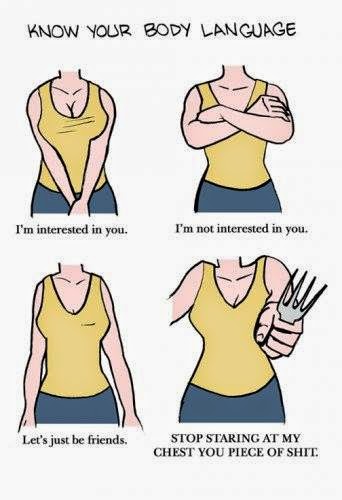Nonverbal communication is a
communication without involving words BUT expressions, body languages,
gestures, movements, external factors (the way we dress).
Benefits of nonverbal communication
1.
You can communicate with someone who is deaf or
weak at hearing.
2.
You can communicate at places where you are
supposed to be silent.
3.
You can communicate something which you don’t
want others to know or listen.
4.
You can communicate when you are far apart in
particular distance.
5.
It makes you conversation short and sweet.
The
functions of Non-Verbal Communication
1.
Integrating Non-Verbal Messages
Non-Verbal Messages may be used
to form or complement impressions, both made to and from you.
·
To accent or emphasize the verbal messages
·
To complement or add nuances of meaning to
verbal messages
·
To contradict the verbal messages
·
To regulate or to try to control verbal messages
·
To repeat or relate the verbal message
nonverbally
·
To substitute for verbal messages
2.
Forming and Managing Impressions
·
To be liked
·
To be believed
·
To avoid failure
·
To secure help
·
To hide faults
·
To be followed
·
To confirm self-image and to communicate it to
others
3.
Defining relationship
Non-verbal communication (NVC) and gestures
are used in various stages of relationships
For example:
For example:
I.
To employers, you tend to look professional and
likeable.
II.
To normal friends, you tend to be casual,
communicating in a more openly way.
III.
To best friends you could go crazy.
IV.
Dating with your girlfriend or boyfriend
4.
Structuring Conversation
5.
Influencing and Deceiving
NVC can be used to influence others into
believing at the same time distracting others.
6.
Express Emotions
The Channels of Non-Verbal Communication
·
Body
Messages
·
Body Appearance
·
Facial Communication
·
Eye Communication
·
Artifactual Communication
·
Silence
·
Time Communication (Chronemics)
Culture and Non-Verbal Communication
·
Culture and Gestures
·
Culture and Facial Expression
·
Culture and Eye Communication
·
Culture and Non-Verbal Communication
How does a
blind man communicate with a deaf man?
Avariety of ways, depending on the individual.
They can, and do, use sign language.
For those that use sign language, you will find that they either use tactile signing or close-vision signing depending on how much vision they have, or what kind of vision loss.
Close vision signing involves the deaf-blind individual being close to the signer, and often they will hold onto the wrists of the signer in order to make it easier to see and track the signs.
Tactile signing involves signing into the hands of the deaf-blind person.
For Example: Helen Keller.
For those that use sign language, you will find that they either use tactile signing or close-vision signing depending on how much vision they have, or what kind of vision loss.
Close vision signing involves the deaf-blind individual being close to the signer, and often they will hold onto the wrists of the signer in order to make it easier to see and track the signs.
Tactile signing involves signing into the hands of the deaf-blind person.
For Example: Helen Keller.
In a nutshell, in our everyday
life, most of us uses verbal messages and goes along with non-verbal messages.
Though we don’t pay much attention on this, people are studying us on how we
behave. It is important to how we control ourselves for the sake of our well-being.
Being happy and yet not showing any signs of happiness don’t make sense at all,
the picture is not complete. Besides that, culture plays an important part in
our life because if we tend to be practicing Japanese culture in Malaysia, it
will look unpleasant, same goes to the opposite way. So, body languages and
verbal communication normally come together in a way to express ourselves. If
there’s only verbal communication, our message can’t be understood by others in
a more proper manner.





















No comments:
Post a Comment